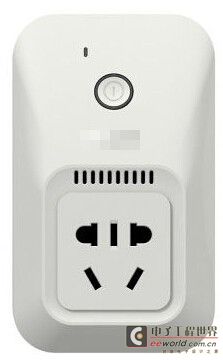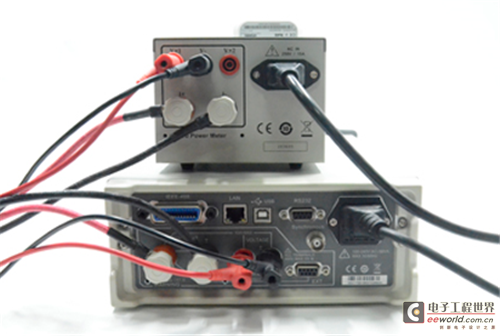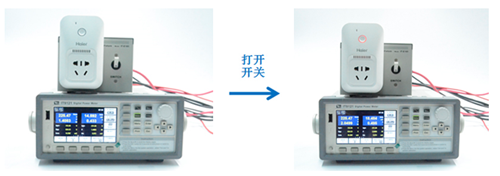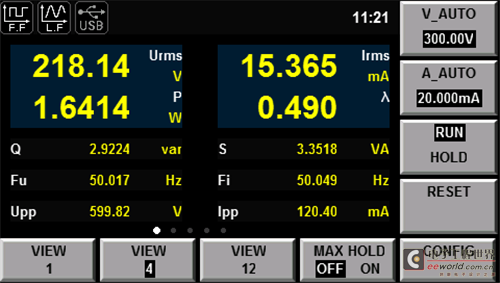With the rapid development of the Internet of Things industry, more and more intelligent devices have entered the daily life of the general public, and smart sockets are one of them. Smart sockets refer to sockets with built-in Wi-FI modules that can be controlled by the client of smart phones. At present, there are many brands of smart socket products on the market, most of which emphasize the intelligence of home furnishings. Then, in the context of energy conservation and environmental protection, as an electrical product used in conjunction with home appliances, its own standby power consumption is the basis of the use value of all smart applications. Why do you say so? Let's take a simple example: the standby power consumption of commonly used LCD color TVs is 8.07W, which will consume 70.69Kw/h in a year, wasting about 40 yuan. It can be seen that the standby power consumption of electrical appliances cannot be underestimated. Today, ITECH randomly selected a brand of smart sockets from the market to test and analyze the standby power consumption.

Standby power consumption refers to the situation when the power supply is connected to 220V mains and all electrical equipment is connected but not started. At this time, the overall power loss mainly comes from the no-load loss of the power supply itself and the standby power consumption of the motherboard. In this state, the actual power consumption of a power supply with good workmanship and materials is generally around 5W to 10W. Next, we will use the IT9121 power meter of ITECH and the corresponding fixture IT-E185 to measure the standby energy consumption of the product under test.
The power consumption is mainly measured by sampling the voltage and current of the power circuit, and analyzing and calculating them through professional instruments. The figure below is a wiring diagram for the test. The IT-E185 fixture of ITECH has an integrated internal circuit and external voltage and current terminals. It is directly connected to the voltage and current input terminals on the rear panel of the IT9121 power meter with wires, eliminating the need for test personnel to operate in series and parallel, and is very convenient to use.

Connect the smart plug to the test fixture, and the original three-hole socket is converted into a smart socket that combines two and three holes. Since the main purpose of this test is to test the standby power consumption, no external electrical equipment is required, just turn on the power switch of the smart socket (the power indicator light is red).

The smart socket contains AC-DC power supply, wireless communication unit, relay and MCU control unit. Therefore, when it enters the standby state, its internal components start to work, thus generating a small working current. During the test, the test interface of the IT9121 power meter is saved through the screenshot function for data analysis. Through analysis, it can be concluded that the standby current of this socket is only about 15mA, and the standby power consumption is less than 2W. Not only that, it is found that there are also parameters such as power factor, active power, frequency, etc. on the measurement interface, which is also of great help to the testing of other items of the smart socket.

Smart sockets are sockets that can be operated through the client of a smartphone on a home wireless network. This is also an important use of smart sockets. When you want to remotely turn on your home water heater, lights and other devices at work, school or on the way home, you can easily control them through a mobile phone APP. This requires our smart sockets to be connected to the Internet all the time. In this case, what is the standby power consumption value?

Through testing, we found that even in the case of LAN control, the standby power consumption is still less than 2W.
According to a survey by the China Energy Conservation Product Certification Center, there are nearly 10 kinds of household appliances with standby or reservation functions in a city household, and the average standby power consumption is between 15W and 30W, which accounts for about 10% of household electricity consumption. Smart sockets have achieved "power off when stopped". If smart sockets are used to control these household appliances, small amounts can be accumulated to avoid more energy loss with tiny standby power consumption, making a huge contribution to environmental protection and energy conservation.
Keywords:Itech
Reference address:Itech evaluates a certain brand of smart sockets - standby power consumption

Figure 1: A certain brand of smart socket
Standby power consumption refers to the situation when the power supply is connected to 220V mains and all electrical equipment is connected but not started. At this time, the overall power loss mainly comes from the no-load loss of the power supply itself and the standby power consumption of the motherboard. In this state, the actual power consumption of a power supply with good workmanship and materials is generally around 5W to 10W. Next, we will use the IT9121 power meter of ITECH and the corresponding fixture IT-E185 to measure the standby energy consumption of the product under test.
The power consumption is mainly measured by sampling the voltage and current of the power circuit, and analyzing and calculating them through professional instruments. The figure below is a wiring diagram for the test. The IT-E185 fixture of ITECH has an integrated internal circuit and external voltage and current terminals. It is directly connected to the voltage and current input terminals on the rear panel of the IT9121 power meter with wires, eliminating the need for test personnel to operate in series and parallel, and is very convenient to use.

Figure 2: Wiring diagram of ITECH smart socket test
Connect the smart plug to the test fixture, and the original three-hole socket is converted into a smart socket that combines two and three holes. Since the main purpose of this test is to test the standby power consumption, no external electrical equipment is required, just turn on the power switch of the smart socket (the power indicator light is red).

Figure 3: Smart socket evaluation in progress
The smart socket contains AC-DC power supply, wireless communication unit, relay and MCU control unit. Therefore, when it enters the standby state, its internal components start to work, thus generating a small working current. During the test, the test interface of the IT9121 power meter is saved through the screenshot function for data analysis. Through analysis, it can be concluded that the standby current of this socket is only about 15mA, and the standby power consumption is less than 2W. Not only that, it is found that there are also parameters such as power factor, active power, frequency, etc. on the measurement interface, which is also of great help to the testing of other items of the smart socket.

Figure 4: Test interface saved using the screenshot shortcut
Smart sockets are sockets that can be operated through the client of a smartphone on a home wireless network. This is also an important use of smart sockets. When you want to remotely turn on your home water heater, lights and other devices at work, school or on the way home, you can easily control them through a mobile phone APP. This requires our smart sockets to be connected to the Internet all the time. In this case, what is the standby power consumption value?

Figure 5: Standby power consumption of smart socket under wireless control
Through testing, we found that even in the case of LAN control, the standby power consumption is still less than 2W.
According to a survey by the China Energy Conservation Product Certification Center, there are nearly 10 kinds of household appliances with standby or reservation functions in a city household, and the average standby power consumption is between 15W and 30W, which accounts for about 10% of household electricity consumption. Smart sockets have achieved "power off when stopped". If smart sockets are used to control these household appliances, small amounts can be accumulated to avoid more energy loss with tiny standby power consumption, making a huge contribution to environmental protection and energy conservation.
Previous article:General principles for sensor selection
Next article:Brief Analysis of Failure of Electromagnetic Flowmeter
- Popular Resources
- Popular amplifiers
Recommended Content
Latest Test Measurement Articles
- Keysight Technologies Helps Samsung Electronics Successfully Validate FiRa® 2.0 Safe Distance Measurement Test Case
- From probes to power supplies, Tektronix is leading the way in comprehensive innovation in power electronics testing
- Seizing the Opportunities in the Chinese Application Market: NI's Challenges and Answers
- Tektronix Launches Breakthrough Power Measurement Tools to Accelerate Innovation as Global Electrification Accelerates
- Not all oscilloscopes are created equal: Why ADCs and low noise floor matter
- Enable TekHSI high-speed interface function to accelerate the remote transmission of waveform data
- How to measure the quality of soft start thyristor
- How to use a multimeter to judge whether a soft starter is good or bad
- What are the advantages and disadvantages of non-contact temperature sensors?
MoreSelected Circuit Diagrams
MorePopular Articles
- Innolux's intelligent steer-by-wire solution makes cars smarter and safer
- 8051 MCU - Parity Check
- How to efficiently balance the sensitivity of tactile sensing interfaces
- What should I do if the servo motor shakes? What causes the servo motor to shake quickly?
- 【Brushless Motor】Analysis of three-phase BLDC motor and sharing of two popular development boards
- Midea Industrial Technology's subsidiaries Clou Electronics and Hekang New Energy jointly appeared at the Munich Battery Energy Storage Exhibition and Solar Energy Exhibition
- Guoxin Sichen | Application of ferroelectric memory PB85RS2MC in power battery management, with a capacity of 2M
- Analysis of common faults of frequency converter
- In a head-on competition with Qualcomm, what kind of cockpit products has Intel come up with?
- Dalian Rongke's all-vanadium liquid flow battery energy storage equipment industrialization project has entered the sprint stage before production
MoreDaily News
- Allegro MicroSystems Introduces Advanced Magnetic and Inductive Position Sensing Solutions at Electronica 2024
- Car key in the left hand, liveness detection radar in the right hand, UWB is imperative for cars!
- After a decade of rapid development, domestic CIS has entered the market
- Aegis Dagger Battery + Thor EM-i Super Hybrid, Geely New Energy has thrown out two "king bombs"
- A brief discussion on functional safety - fault, error, and failure
- In the smart car 2.0 cycle, these core industry chains are facing major opportunities!
- The United States and Japan are developing new batteries. CATL faces challenges? How should China's new energy battery industry respond?
- Murata launches high-precision 6-axis inertial sensor for automobiles
- Ford patents pre-charge alarm to help save costs and respond to emergencies
- New real-time microcontroller system from Texas Instruments enables smarter processing in automotive and industrial applications
Guess you like
- How can I reduce the brightness of the four-digit digital tube? If I don't change the program, what hardware should I change?
- Compilation error, please help me! ! !
- Recruitment: Beijing high-power switching power supply R&D manager
- Can the STM32 DMA be set to an interrupt with any index?
- Ground pad processing issues in AD package library
- I want to buy a complete solution based on HiSilicon 3516EV200 or similar HiSilicon chips.
- MS2351M replaces AD8314 RF power detection chip
- Method for software simulation of core reset of SinoWise M0+ core chip
- Factors to consider when allocating FPGA pins
- Qian Xuesen named VR Lingjing 30 years ago

 LF198AL
LF198AL











 京公网安备 11010802033920号
京公网安备 11010802033920号